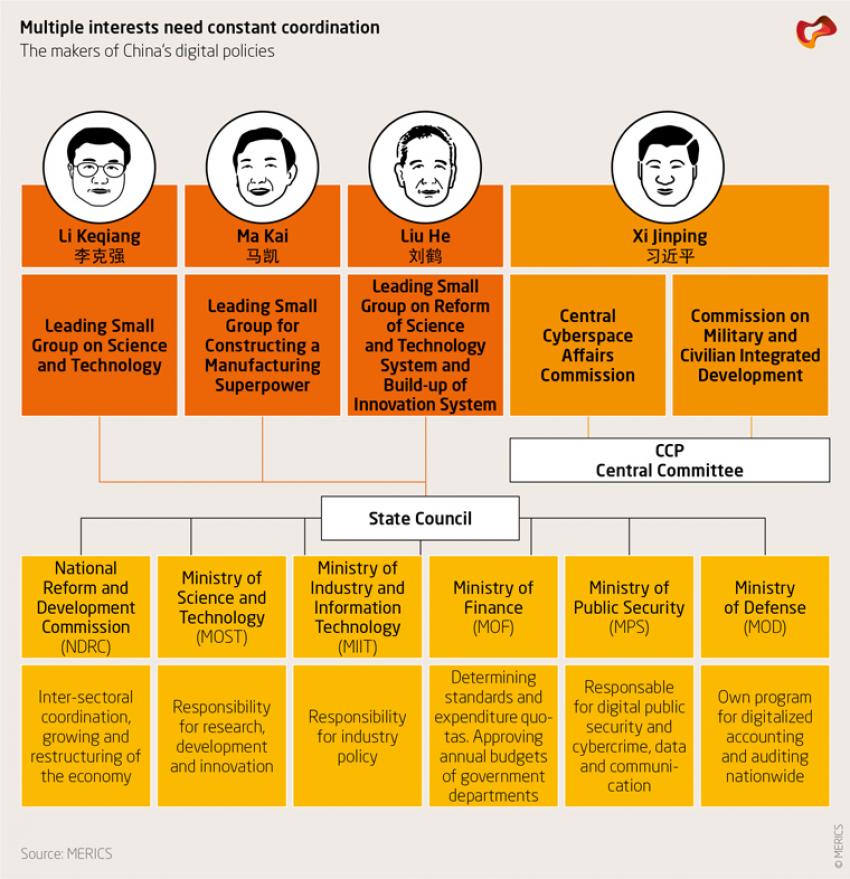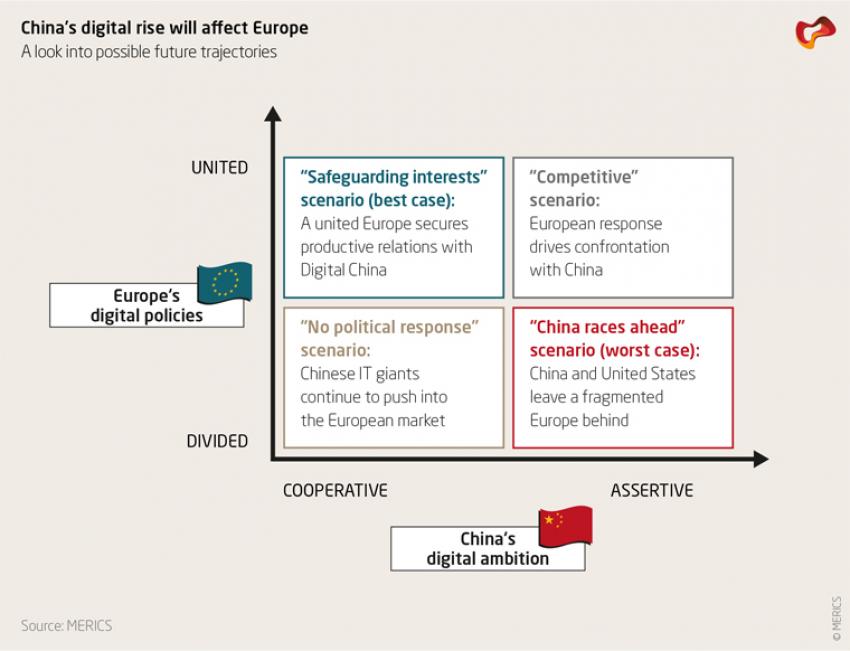

China's Digital Rise
Challenges for Europe
China's efforts at home and abroad to become a global leader in digital technologies is a challenge for Europe. The ambitions of telecommunications giant Huawei to participate in building European 5G networks are just one example of many, say MERICS researchers Kristin Shi-Kupfer and Mareike Ohlberg, authors of the MERICS study, "China's digital rise. Challenges for Europe.”
You can read the Executive Summary of the report below or download the report as PDF here:
Executive Summary
- China is making headway in achieving global leadership in 5G, AI and quantum computing and in other digital and disruptive technologies
- The Chinese Communist Party (CCP) is pursuing a comprehensive digital strategy encompassing the search for new economic growth drivers, cyber governance and global power projection
- Selected leading Chinese ICT companies are co-shaping the global digital architecture
- With its proactive approach to standardization, China sets operational rules for foreign businesses
- China’s weak regulatory environment will impact on the development of digital ethics on a global level
The reach of Chinese IT companies into global digital infrastructure is raising growing concerns in Europe. Large and partially state-backed companies like Huawei, Alibaba or Tencent are already involved Europe-wide in telecommunications networks, data centers and online payment systems. The introduction of the new telecommunications standard 5G will likely contribute to Huawei’s hard- and software becoming yet more entangled in Europe’s critical infrastructure. China is the only country that is ahead of the UN’s International Telecommunication Union’s “2020 5G development schedule”. Chinese experts have taken the lead role in the 5G group of the International Standardization Organization (ISO), known as 3GPP, by submitting 40 percent of the standards and 32 percent of the documents.
The global leadership of Chinese telecoms giants in 5G is just one example of how China is on its way to becoming a digital innovation powerhouse. President Xi Jinping has emphasized the importance of China becoming a leader in emerging technologies – including artificial intelligence (AI), nanotechnology, quantum computing, big data, cloud computing, and smart cities. China has spent at least ten times more on quantum R&D than the United States; estimates start from USD 50 billion. In the AI sector, China filed 30,000 patents in 2018 alone, 2.5 times more than the United States. China has also announced plans to invest USD 411 billion in upgrading its telecommunications systems to 5G between 2020 and 2030.
China is well on its way to being a global leader in key emerging and digital technologies. It is a leading digital marketplace and home of one third of unicorns, privately held start-up companies valued at over USD 1 billion. China has made substantial headway in AI-based applications like facial recognition, in blockchain technologies and quantum computation. It has achieved substantial growth across multiple other sectors, such as logistics, e-commerce, fintech, autonomous driving, and digital health.
And Chinese companies are competing successfully worldwide in ICT products and services. Beijing is proactively shaping international standards for emerging technologies including blockchain, Internet of Things (IoT) and 5G, by securing leadership positions in international standard setting bodies.
For Europe, the loss of economic competitiveness in these fields is becoming a pressing concern. At the same time, the fact that Chinese high-tech enterprises are gradually conquering European markets and their digital technologies are increasingly found in fintech, e-commerce and telecoms structures in Europe feeds into worries over potential security risks. The ongoing transfer of dual-use technologies from Europe to China adds to these concerns.
China's digital ambitions are backed by strong policy coordination and a nexus of party state and private interests
China’s digital strategy covers its entire economy and society. It envisions rapid technological advances to generate fresh economic growth, foster effective governance and control, and project global power. The strategy combines economic targets with broader normative and security goals. The Chinese Communist Party (CCP) wants to advance technologically, amplify China’s “discursive power” and shape global standards and norms.
Multiple major policy initiatives support these goals: the National Informatization Strategy (2016 – 2020) calls upon China’s internet companies to “go out” into the world and support the creation of a “Digital Silk Road”. The “Made in China 2025” roadmap and “Internet Plus” were launched in 2015 to drive domestic industrial and digital innovation. The digital sector has been a major beneficiary of President Xi’s policy style, which relies on taskspecific Leading Small Groups to quickly implement decisions made by the top leadership in sectors that are considered a priority.
On the ground, a unique party-state-private nexus in the ICT sector underpins China’s digital policies. The CCP has nurtured the home-grown IT champions Baidu, Alibaba and Tencent (known as “BAT”) by blocking foreign competitors from the domestic market. The party state also allowed BAT to expand internationally and to access foreign capital with listings on overseas stock markets. In the case of ZTE and Huawei, the two major Chinese telecommunication equipment manufacturing companies, party-state co-optation in the form of government funding and preferential procurement has been particularly evident. It can be hard-to-impossible to track the web of party influence, state control mechanisms and international linkages that surrounds China’s sprawling ecosystem of innovative startups, venture capital funds, local and provincial governments – and the military.
China enjoys structural advantages in advancing its bold plans to digitize the economy and achieve global technological leadership. Beijing channels massive amounts of capital through state guidance funds into emerging technologies. In line with the unofficial slogan “First develop, then regulate,” the government enables commercial actors to innovate and swiftly produce market-ready products for a digital ecosystem protected from foreign competition.
China is investing heavily in different areas of technological innovation: For instance, training new talent is a prioritized sphere of action. In AI, China intends to establish at least 50 academic and research institutes by 2020. China’s government hopes to gain substantial economic benefits by pushing digital innovation within and beyond its borders: for instance, it is estimated that products and developments for the Internet of Things (IoT) alone could add up to 1.8 trillion USD in cumulative GDP growth for China by 2030.
However, China’s digital strategy should not be viewed as a purely economic exercise. Civilmilitary integration has been a top-level national strategy since 2014. Efforts to become a “science and tech superpower” should be seen in close connection with ambitions to dominate in emerging dual-use technologies, advance cyber warfare capabilities, weaponize AI and achieve quantum supremacy.
Utilizing digital innovation for political and societal control
China’s drive for digitalization goes beyond economic ambitions: Beijing wants to use digital technologies for effective governance and control over companies and citizens. It is focusing on two main goals:
a) protecting critical infrastructure and data from foreign access, and
b) establishing big data-based control mechanisms to monitor enterprises and citizens in order to enforce compliant and conformist behavior.
The CCP has invented powerful tools to pursue its vision of cyber governance, social management and control. The Cyber Security Law, effective since July 2017, regulates the protection of IT infrastructure and systems, data management for public services, and governs the regulatory compliance of economic and societal actors. Access for foreign companies to China’s digital and telecommunications markets will remain restricted due to informal barriers created by strict regulations on cyber and data security.
Plans to introduce a nationwide “Social Credit System” (SoCs), a big data-fueled toolkit to enforce laws, regulations, or party-state targets by scoring companies and individuals, are progressing. Currently, they consist of more than 40 fragmented local government SoCs pilot programs and numerous commercial pilots set up by technology firms. However, they could become a powerful and comprehensive instrument to steer the behavior of citizens and organizations.
Weaknesses in China's approach
Despite the structural advantages described above, China’s digitalization strategy faces multiple internal and external challenges that could derail its ambitions. Internally, conflicting goals and stakeholder interests create substantial tensions. Heightened party control over private companies and inefficient allocation of capital may ultimately also come at the expense of innovation. China will still depend on foreign core technologies in the years to come. This became apparent last year, when ZTE almost went bankrupt after the United States threatened a ban on selling microchips to the telecommunications supplier.
More broadly, Beijing’s industrial and technology policies, as well as digital-related laws and regulations such as the Cyber Security Law are increasingly putting China in conflict with other international actors, in particular the United States. The global backlash against China’s digital and technological rise has probably only just begun.
In spite of these challenges, China will pursue its drive for digital innovation and leadership. China’s leaders view achieving leadership of global technological progress as a political project charged with nationalist and ideological significance.
China's digital policies put pressure on Europe
China’s digital ambitions already have an impact on Europe’s politics, economics, and security. The “Digital Silk Road” is likely to deepen China’s digital reach into Europe. Going forward, the EU faces the growing commercial presence of, and critical dependence on, China’s most competitive IT players. IP protection in research collaborations and other new regulatory challenges in managing interlinked digital markets will emerge as major challenges going forward.
In cyber security, the EU is confronted with a direct challenge from China’s digital outreach. European companies and government bodies have suffered commercial espionage and cyber-crime originating from Chinese institutions. The growing presence of major Chinese ICT suppliers including Huawei and ZTE creates substantial uncertainties and potential security risks for EU member states.
China’s growing digital reach is likely to have more direct negative consequences for European politics and core values. Many aspects of China’s social credit system run counter to the EU’s values, including the lack of privacy protection and freedom of expression, and to EU efforts to establish digital ethics standards. European citizens’ privacy, safety and rights need protection from Chinese government encroachment and – by extension – from commercial actors who could collect and use data on EU citizens and others within EU territory.
China’s high-tech rise is not a threat to the EU per se: if innovation were based on reciprocal and transparent cooperation, transcending protectionist logic, all sides could benefit from new ideas and developments. But if China pursues a path of self-reliance this will pose fundamental challenges to co-operation and mutual confidence. The EU’s current lack of a truly European innovation eco-system and its politically inconsistent responses to China suggest it will struggle to cope.
European decision-makers need to prevent a worst-case scenario in which a fragmented EU faces a digitally aggressive China competing with the US in a fragmented digital global economy. An immediate concern should be how the EU manages transatlantic relations in such as context, i.e., how European governments deal with the lure of economic opportunities related to China’s digital transformation in a situation where the United States anticipates this space as crucial for strategic competition with China.
Unless Europe catches up and becomes competitive in key digital technologies, it faces an imminent risk of finding itself trapped between China and the United States. The EU and its member states need to join forces to prioritize strengthening the European digital market, by developing secure supply-chains among trusted partners for core digital technologies and devising strategically effective and autonomous digital policies.
Digital China is challenging Europe on several levels. Opportunities for collaboration exist, however, Europe needs to safeguard its interests in a fast changing economic and technological environment. European policy makers need to double down on developing a strategically autonomous, unified digital policy and strive for a joint approach in tackling cyber security issues in Europe.
Facing China’s digital rise, Europe needs to seek greater alignment with third countries like the United States, South Korea or Japan in pushing back jointly against China’s subsidized industrial policy and its emphasis on indigenous innovation that fosters digital protectionism. Europe also needs to rapidly expand work with like-minded partners towards agreements on privacy, data localization and cyber standards, as well as free and safe data flows. Vigilance, unity and leverage will be needed to prevail in a digital world that is increasingly shaped by China.




